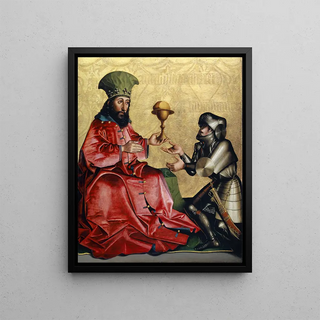Art print | Abraham before Melchizedek - Konrad Witz


View from behind

Frame (optional)
The artwork "Abraham before Melchizedek" by Konrad Witz is a masterpiece that evokes not only the spiritual depth of its subject but also the technical skill of its creator. This painting, which immerses the viewer in a biblical scene rich in symbolism, invites exploration of the mysteries of faith and royalty. Witz, a Renaissance artist, succeeds in capturing the very essence of a pivotal moment in sacred history, where Abraham, the patriarch, meets Melchizedek, king of Salem and priest of God. This dialogue between the divine and the human is highlighted by a carefully orchestrated composition, where every detail seems to carry a particular significance. Through this work, the artist transports us to a universe where the sacred and the profane intersect, offering a reflection on the nature of spirituality.
Style and uniqueness of the work
Witz's style is distinguished by remarkable finesse in the treatment of human figures and landscapes. In "Abraham before Melchizedek," the precision of the lines and the delicacy of the expressions confer emotional depth to the scene. The artist skillfully plays with light and shadow, creating striking contrasts that emphasize the drama of the encounter. The colors, both rich and harmonious, evoke an atmosphere of serenity while highlighting the solemnity of the moment. The composition is balanced, with each character occupying a strategic position that reinforces the narrative meaning of the work. The interaction between Abraham and Melchizedek is emphasized by a symbolic gesture, where the king offers bread and wine, foreshadowing the Eucharist. This iconographic choice reflects the theological depth of the work, inviting the viewer to meditative contemplation.
The artist and his influence
Konrad Witz, active in the 15th century, is often regarded as a pioneer in Swiss painting. His innovative approach combines influences from late Gothic and early Renaissance, allowing him to create highly expressive works. Witz is recognized for his ability to integrate narrative and symbolic elements

Matte finish

View from behind

Frame (optional)
The artwork "Abraham before Melchizedek" by Konrad Witz is a masterpiece that evokes not only the spiritual depth of its subject but also the technical skill of its creator. This painting, which immerses the viewer in a biblical scene rich in symbolism, invites exploration of the mysteries of faith and royalty. Witz, a Renaissance artist, succeeds in capturing the very essence of a pivotal moment in sacred history, where Abraham, the patriarch, meets Melchizedek, king of Salem and priest of God. This dialogue between the divine and the human is highlighted by a carefully orchestrated composition, where every detail seems to carry a particular significance. Through this work, the artist transports us to a universe where the sacred and the profane intersect, offering a reflection on the nature of spirituality.
Style and uniqueness of the work
Witz's style is distinguished by remarkable finesse in the treatment of human figures and landscapes. In "Abraham before Melchizedek," the precision of the lines and the delicacy of the expressions confer emotional depth to the scene. The artist skillfully plays with light and shadow, creating striking contrasts that emphasize the drama of the encounter. The colors, both rich and harmonious, evoke an atmosphere of serenity while highlighting the solemnity of the moment. The composition is balanced, with each character occupying a strategic position that reinforces the narrative meaning of the work. The interaction between Abraham and Melchizedek is emphasized by a symbolic gesture, where the king offers bread and wine, foreshadowing the Eucharist. This iconographic choice reflects the theological depth of the work, inviting the viewer to meditative contemplation.
The artist and his influence
Konrad Witz, active in the 15th century, is often regarded as a pioneer in Swiss painting. His innovative approach combines influences from late Gothic and early Renaissance, allowing him to create highly expressive works. Witz is recognized for his ability to integrate narrative and symbolic elements






